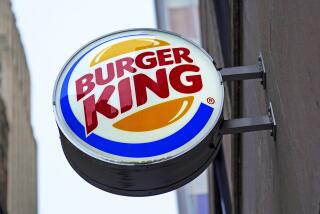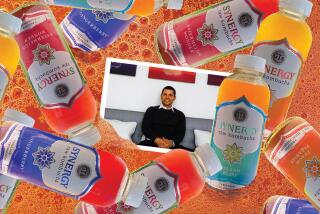Court Ruling Fails to Melt Double Rainbow’s Resolve
- Share via
SAN FRANCISCO — For five years now, pint-size Double Rainbow, a popular San Francisco ice cream maker, has portrayed its legal bout with Haagen-Dazs as a classic David vs. Goliath struggle.
Since 1985, Double Rainbow has been battling to get before a jury to plead its case that Haagen-Dazs has hogged the lucrative market for ultra-rich ice creams by preventing its smaller rival from getting into grocery store freezers.
Double Rainbow contends that Haagen-Dazs, a former Pillsbury unit now owned by a British conglomerate, has violated antitrust laws by unfairly preventing independent distributors from carrying competing brands. The practice, Double Rainbow said, has thwarted its own efforts to launch a nationwide push.
But so far Double Rainbow has been getting licked in the courts. Last month, it lost another key round when a three-judge panel of the U.S. 9th Circuit Court of Appeals upheld a lower court’s ruling that Haagen-Dazs could indeed demand the loyalty of distributors.
Now the entrepreneurial “David” is using an unusual strategy--aiming its slingshot at the very justices whom it is trying to persuade to rehear the case.
“An insult to the taste buds of America” is how Steven H. Fink, co-founder and co-owner of Double Rainbow Gourmet Ice Creams, describes the justices’ determination that all ice creams are basically alike and that Haagen-Dazs, with 2% of the $9.5-billion overall market, therefore does not have a monopoly. Fink has argued that luxury ice creams, of which Haagen-Dazs is the clear leader, form a market of their own apart from economy brands.
His lawyer went even further, impugning the justices’ grasp of the law. In documents filed last month, he said that they goofed in siding with Haagen-Dazs because they were “confused by” and “ignored” legal precedents.
So how will this go over?
“They’ll probably get mad at me,” said John H. Boone, the attorney. If the appeals court refuses to rehear the case, Boone said, he will take it to the U.S. Supreme Court.
For its part, Haagen-Dazs, based in Teaneck, N.J., maintains that Double Rainbow simply has a weak case.
“They’ve cried wolf all along, but the facts just aren’t there,” said William C. Miller, a Haagen-Dazs attorney in San Francisco.
The case, Fink said, demonstrates how tough life can be for the little guy in America.
“Right now, it’s not a battle of the best but of the most powerful,” Fink said.
In his view, the controversy has forced him and his partner, Michael P. Sachar, to scale back their dreams of a pot of gold.
The two men from Brooklyn--who as childhood pals sold ice cream at Coney Island and concocted their own in the Fink family kitchen--opened their first ice cream store on San Francisco’s Castro Street in February, 1977, naming it for the double rainbow that Fink had seen the day they signed the lease.
In the 200-square-foot store, they sold Haagen-Dazs ice cream.
As their second location was going up, they were visited one day by Doris Mattus, daughter of Haagen-Dazs founder Reuben Mattus. According to Fink, she demanded that they shut down the stores or become Haagen-Dazs franchisees.
When Fink and Sachar refused, Haagen-Dazs, at the time owned by Pillsbury, threatened to stop shipping to them. (Grand Metropolitan PLC, a British food and drink conglomerate, bought Haagen-Dazs along with the rest of Pillsbury in late 1988.)
As Fink tells it, the Double Rainbow team sued to win a nine-month reprieve. During that time, the two developed a luxury ice cream and sold it in their stores.
Double Rainbow quickly became a favorite of Bay Area ice cream lovers and began garnering a national reputation. In 1982, the company’s vanilla took top honors at the Great American Lick-Off in Philadelphia.
In a former burrito factory on South Van Ness, the company now makes 40 flavors for 32 franchise stores (including six in Southern California) and three company-owned stores. In addition, it sells to 150 restaurants.
But it’s a different story when it comes to supermarket sales, where contenders in the super-premium ice cream category have waged a heated battle for freezer space.
Whereas Fink and Sachar once envisioned that their product would be available in top chains across the land, today their eight prepackaged flavors are sold only at Trader Joe’s, Price Club and a few mom-and-pop places. In fact, Fink said, grocery sales have shrunk to $200,000 from $1 million in 1987.
Here’s why, he said. In February, 1985, Two Count Inc., a Haagen-Dazs distributor based in Newark, Calif., agreed to distribute Double Rainbow. Haagen-Dazs soon dropped Two Count, saying it demanded loyalty by its independent distributors. After that, Fink said, other big distributors would not touch Double Rainbow.
Fink, an intense, bearded man, figures that the distribution woes “stopped us in our tracks.” Current annual sales of $3.5 million, he said, are well shy of the $40 million he estimates that the company could have done on a national scale. (He estimates that Haagen-Dazs sales in the last five years have surged to $275 million from $80 million.)
He noted that Ben & Jerry’s Homemade, a Vermont ice cream company, fought a similar battle with Haagen-Dazs over distribution. That case was settled in 1984, after the firm waged a campaign against Pillsbury with the slogan, “What’s the Doughboy Afraid Of?”
The settlement allowed Ben & Jerry’s to use Haagen-Dazs distributors in two Northeastern states long enough so that it could develop its own network.
In the last few years, Fink added, many small start-ups in the super-premium ice cream business have failed or been bought by large companies with deep pockets for promotion and litigation. Philip Morris Cos.’ Kraft unit, for example, owns Frusen Gladje.
Bob Walsh, Two Count’s president and one of the founder’s four sons, said the loss of Haagen-Dazs, which represented 40% of the company’s business, has taken a severe toll on his company as well. Two Count has since rapidly expanded its distribution in an effort to recoup the lost business, but profits have suffered, he said.
Despite Fink’s campaign, his comments reek of resignation.
“If I never win this lawsuit,” he said, “I still make a great ice cream.” Double Rainbow may have to be content with just being “a successful local company.”
But with a hint of the old defiance that once prompted him to demonstrate outside Pillsbury’s Minneapolis headquarters in 20-below weather, he added: “I never thought I’d (spend) five years trying to get in front of a jury. . . . We’re survivors. (But) I’m real scared for the small businessman in America.”
More to Read
Inside the business of entertainment
The Wide Shot brings you news, analysis and insights on everything from streaming wars to production — and what it all means for the future.
You may occasionally receive promotional content from the Los Angeles Times.











